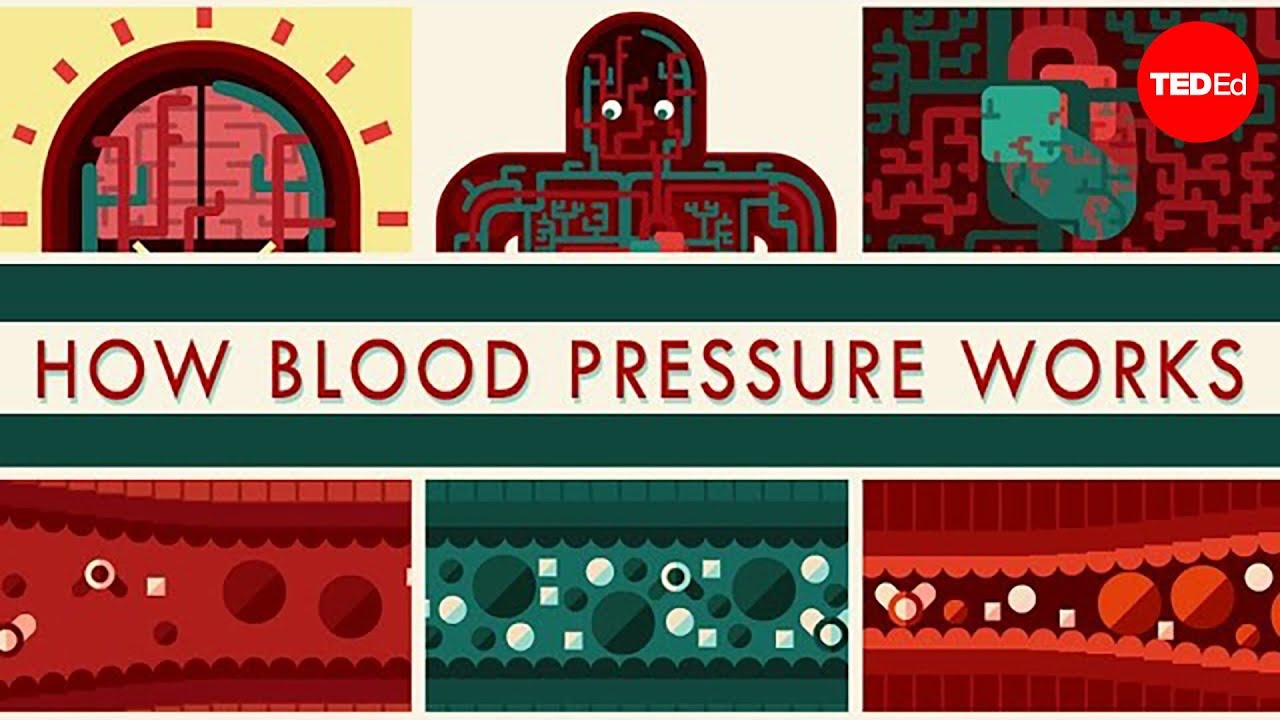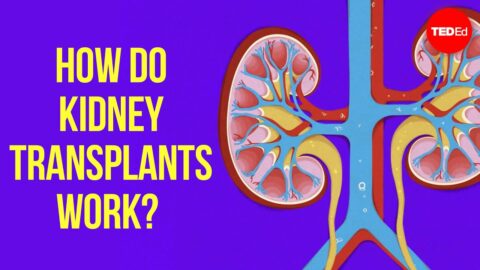If you lined up all the blood vessels in your body,
Se você alinhasse todos os vasos sanguíneos do seu corpo,
they'd be 95,000 kilometers long
eles teriam 95.000 quilômetros de comprimento
and everyday, they carry the equivalent of over 7,500 liters of blood,
e todos os dias transportam o equivalente a mais de 7.500 litros de sangue,
though that's actually the same four or five liters recycled over and over,
embora na verdade sejam os mesmos quatro ou cinco litros reciclados repetidamente,
delivering oxygen, and precious nutrients
fornecendo oxigênio e nutrientes preciosos
like glucose and amino acids to the body's tissues.
como glicose e aminoácidos para os tecidos do corpo.
All that blood exerts a force on the muscular walls of the blood vessels.
Todo esse sangue exerce uma força sobre as paredes musculares dos vasos sanguíneos.
That force is called blood pressure,
Essa força é chamada de pressão arterial,
and it rises and falls with the phases of the heartbeat.
e sobe e desce com as fases do batimento cardíaco.
It's highest during systole,
É mais alto durante a sístole,
when the heart contracts to force blood through the arteries.
quando o coração se contrai para forçar o sangue através das artérias.
This is your systolic blood pressure.
Esta é a sua pressão arterial sistólica.
When the heart is at rest between beats,
Quando o coração está em repouso entre as batidas,
blood pressure falls to its lowest value, the diastolic pressure.
a pressão arterial cai para seu valor mais baixo, a pressão diastólica.
A typical healthy individual produces a systolic pressure
Um indivíduo saudável típico produz uma pressão sistólica
between 90 and 120 millimeters of mercury,
entre 90 e 120 milímetros de mercúrio,
and diastolic pressure between 60 and 80.
e pressão diastólica entre 60 e 80.
Taken together, a normal reading is a bit less than 120 over 80.
Somados, uma leitura normal é um pouco menor que 120 por 80.
The blood traverses the landscape of the body
O sangue atravessa a paisagem do corpo
through the pipes of the circulatory system.
através dos tubos do sistema circulatório.
In any plumbing system,
Em qualquer sistema de encanamento,
several things can increase the force on the walls of the pipes:
várias coisas podem aumentar a força nas paredes dos tubos:
the properties of the fluid,
as propriedades do fluido,
extra fluid,
fluido extra,
or narrower pipes.
ou tubos mais estreitos.
So if the blood thickens,
Então, se o sangue engrossar,
a higher pressure is needed to push it, so the heart will pump harder.
é necessária uma pressão maior para empurrá-lo, para que o coração bombeie com mais força.
A high-salt diet will lead to a similar result.
Uma dieta rica em sal levará a um resultado semelhante.
The salt promotes water retention,
O sal promove a retenção de água,
and the extra fluid increases the blood volume and blood pressure,
e o fluido extra aumenta o volume sanguíneo e a pressão arterial,
and stress, like the fight or flight response,
e estresse, como a resposta de luta ou fuga,
releases hormones, like epinephrine and norepinephrine
libera hormônios, como epinefrina e norepinefrina
that constrict key vessels,
que contraem os vasos principais,
increasing the resistance to flow and raising the pressure upstream.
aumentando a resistência ao fluxo e elevando a pressão a montante.
Blood vessels can usually handle these fluctuations easily.
Os vasos sanguíneos geralmente conseguem lidar facilmente com essas flutuações.
Elastic fibers embedded in their walls make them resilient,
Fibras elásticas incorporadas em suas paredes os tornam resilientes,
but if your blood pressure regularly rises above about 140 over 90,
mas se a sua pressão arterial sobe regularmente acima de 140 por 90,
what we call hypertension, and stays there,
o que chamamos de hipertensão, e permanece lá,
it can cause serious problems.
pode causar problemas sérios.
That's because the extra strain on the arterial wall
Isso ocorre porque a pressão extra na parede arterial
can produce small tears.
pode produzir pequenos rasgos.
When the injured tissue swells up,
Quando o tecido lesionado incha,
substances that respond to the inflammation,
substâncias que respondem à inflamação,
like white blood cells, collect around the tears.
como glóbulos brancos, acumulam-se ao redor das lágrimas.
Fat and cholesterol floating in the blood latch on, too,
A gordura e o colesterol que flutuam no sangue também se fixam,
eventually building up to form a plaque
eventualmente acumulando-se para formar uma placa
that stiffens and thickens the inner arterial wall.
que enrijece e engrossa a parede arterial interna.
This condition is called atherosclerosis,
Essa condição é chamada de aterosclerose,
and it can have dangerous consequences.
e pode ter consequências perigosas.
If the plaque ruptures, a blood clot forms on top of the tear,
Se a placa se romper, um coágulo de sangue se formará na parte superior do rasgo,
clogging the already narrowed pipe.
obstruindo o cano já estreitado.
If the clot is big enough,
Se o coágulo for grande o suficiente,
it can completely block the flow of oxygen and nutrients to cells downstream.
pode bloquear completamente o fluxo de oxigênio e nutrientes para as células a jusante.
In vessels that feed the heart,
Nos vasos que alimentam o coração,
that will cause a heart attack,
que causará um ataque cardíaco,
when oxygen-deprived cardiac muscle cells start to die.
quando as células musculares cardíacas privadas de oxigênio começam a morrer.
If the clot cuts off blood flow to the brain,
Se o coágulo interromper o fluxo sanguíneo para o cérebro,
it causes a stroke.
isso causa um derrame.
Dangerously clogged blood vessels can be widened
Vasos sanguíneos perigosamente obstruídos podem ser alargados
by a procedure called an angioplasty.
por um procedimento chamado angioplastia.
There, doctors thread a wire through the vessel
Lá, os médicos passam um fio pelo vaso
to the obstructed site,
para o local obstruído,
and then place a deflated balloon catheter over the wire.
e então coloque um cateter de balão vazio sobre o fio.
When the balloon is inflated, it forces the passageway open again.
Quando o balão é inflado, ele força a passagem a se abrir novamente.
Sometimes a rigid tube called a stent
Às vezes, um tubo rígido chamado stent
is placed in a vessel to held hold it open,
é colocado em um recipiente para mantê-lo aberto,
letting the blood flow freely
deixando o sangue fluir livremente
to replenish the oxygen-starved cells downstream.
para repor as células carentes de oxigênio a jusante.
Staying flexible under pressure is a tough job for arteries.
Manter-se flexível sob pressão é uma tarefa difícil para as artérias.
The fluid they pump is composed of substances
O fluido que bombeiam é composto de substâncias
that can get sticky and clog them,
que podem ficar pegajosos e entupi-los,
and your typical healthy heart beats about 70 times a minute,
e seu coração saudável típico bate cerca de 70 vezes por minuto,
and at least 2.5 billion times during an average lifetime.
e pelo menos 2,5 bilhões de vezes durante uma vida média.
That may sound like an insurmountable amount of pressure,
Isso pode parecer uma pressão intransponível,
but don't worry, your arteries are well suited for the challenge.
mas não se preocupe, suas artérias são adequadas para o desafio.
Legenda Anterior
Pronunciar Palavra
Traduzir Frase Atual
Pausar / Play
Aumentar Fonte Legenda
Próxima Legenda
Pronunciar Frase
Dois Cliques para Salvar Palavra
Desativar Legenda / Ativar Legenda
Diminuir Fonte Legenda













